Process for making UHF antennas for EAS and RFID tags and antennas made thereby
a technology of uhf antennas and antennas, which is applied in the field of making uhf antennas, can solve the problems of not being the most cost-effective method for producing very thin uhf antennas, and the techniques of u.s. pat. no. 6,988,666
- Summary
- Abstract
- Description
- Claims
- Application Information
AI Technical Summary
Benefits of technology
Problems solved by technology
Method used
Image
Examples
Embodiment Construction
[0024] Referring now to the various figures of the drawings wherein like reference characters refer to like parts there is shown at 20 in FIG. 1 a system 20 for carrying out one exemplary method of this invention to produce a series of UHF antennas in a very expeditious manner and at a very low cost. As will be appreciated by those skilled in the art from the description to follow, those advantages stem at least partially from the fact that the methods of this invention can be accomplished using standard installed equipment that has been available for several decades in the label converting industry, but modified as will be described below to fabricate UHF antennas.
[0025] The exemplary system 20 of FIG. 1 basically comprises a reel 22 containing a flexible liner or carrier web 24 (FIGS. 1 and 2) and a flexible conductive laminate web 26 (FIGS. 1 and 2) releasably secured to the carrier web by a layer of any suitable adhesive 28 (FIG. 2), e.g., hot melt, or water based systems, usin...
PUM
| Property | Measurement | Unit |
|---|---|---|
| thickness | aaaaa | aaaaa |
| thickness | aaaaa | aaaaa |
| frequency | aaaaa | aaaaa |
Abstract
Description
Claims
Application Information
 Login to View More
Login to View More - R&D
- Intellectual Property
- Life Sciences
- Materials
- Tech Scout
- Unparalleled Data Quality
- Higher Quality Content
- 60% Fewer Hallucinations
Browse by: Latest US Patents, China's latest patents, Technical Efficacy Thesaurus, Application Domain, Technology Topic, Popular Technical Reports.
© 2025 PatSnap. All rights reserved.Legal|Privacy policy|Modern Slavery Act Transparency Statement|Sitemap|About US| Contact US: help@patsnap.com



